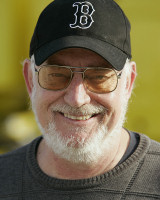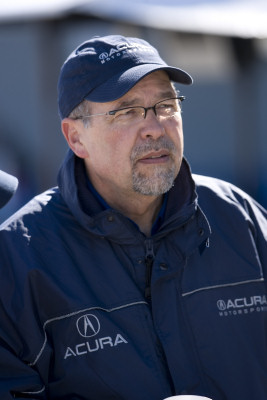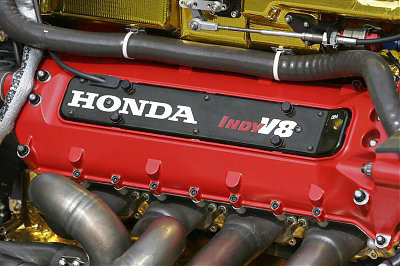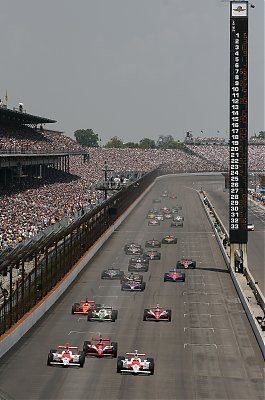The Way It Is/ Honda's Robert Clarke analyzes the challenges facing the Indy Racing League
by Gordon Kirby On Monday, Robert Clarke reflected on his fifteen years running Honda Performance Development and his most recent efforts in establishing this year's Acura ALMS program. Today, Clarke discusses Honda's IRL engine program and looks at where it may, or may not be heading.
On Monday, Robert Clarke reflected on his fifteen years running Honda Performance Development and his most recent efforts in establishing this year's Acura ALMS program. Today, Clarke discusses Honda's IRL engine program and looks at where it may, or may not be heading.
Over the past two years, of course, Honda has been the spec engine supplier to the IRL and is contracted to continue in this role through 2009. Without any competition Honda's focus in the IRL is on showcasing the quality of its products by achieving and maintaining a perfect reliability record, and with this goal in mind Honda's IRL engine supply program is ticking over comfortably with only minor changes for next season.
"HPD and Ilmor's support of the IRL engine program is a pretty well-oiled machine right now," Clarke observed. "It's not a difficult program, other than we're concerned that we'll get lazy at some point and start letting the quality slip. That's something we keep reminding ourselves of. We have reflection meetings quarterly and keep beating-up on each other to make sure the quality is maintained. It's the only thing we have and we can't lose that.
"We had to make some fairly significant changes from last year to this year because of the move to ethanol, but from this year to next there only a few minor things we are doing. One is we're trying to improve the overall life of the engine to make it even more economical for us and for the teams, too. We're also trying to improve on the oil control so we have less oil consumption and less likelihood for detonation, just trying to make the engine a bit more robust. The League is introducing a paddle shift system for next year so that requires an electric throttle blipper on the side of the engine and some software changes to the ECU to accommodate it."
Clarke has also been pushing to create a quieter exhaust note. "We've prototyped a new exhaust silencer system that gets the engine down another ten decibels. It should definitely be noticeable."
Regretfully, Clarke is not happy with the results of the Indy car of 2011 design concept project with the Art Center College of Design in Pasadena. "The whole point of that program in my mind was to get the IRL thinking about things beyond what we have today," he commented. "I think they were struggling with doing that. As far as a particular design coming out of it and everybody saying, 'Oh, that's it! Let's get that off to a chassis manufacturer and build it.' I never expected that, but I'm not thrilled with what came out of it as far as car design."
Honda supported a similar project with the Art Center College back in 1994 when the company was first breaking into Indy car racing. "At that point all the designers were transportation designers," Clarke observed. "This time we took a team approach where there were transportation designers, entertainment designers, environmental design, product design and graphic design. That was a good thing, but also maybe a bad thing as far as the car went.

©
"The point we made to the students--and none of them really achieved it--is that what I feel we truly need is an iconic design that people can say: There's no question, that's an Indy car, and it's uniquely different than any other open-wheel car. With everything we have today, the lay person can't tell the difference between a Champ car, an Indy car, or Formula 1 car, or any other kind of car. Really, all open-wheel cars have all looked about the same since the mid-seventies."
Clarke was equally disappointed when he discussed his concept with Nick Wirth of Wirth Research who are involved in the development of the Acura ALMS car. "I sat down with Nick and shared with him a lot of the same thoughts I shared with the Art Center students. He got excited and went off and did his own thing, and what he came back with looked like a big Formula Ford car! It was basically the same layout. The trouble with race car designers is that they're not open-minded enough."
Clarke would like to see the IRL take what he considers to be the next step which is to engage the world's customer race car manufacturers in a real-world design contest. "I've suggested to the League that we've taken this student design approach. Why don't we now in effect put it out for a design contest with the chassis manufacturers. That's often what happens with an architectural project for, example. A number of architects are given briefs on what you wish to achieve and they come back with proposals of new design projects."
Of course, car builders like Lola in the UK, Dallara in Italy, and Riley in the USA, do this kind of thing on a regular basis whether it's building a new spec car or sports car. But Clarke reiterated his key point that the Indy car of 2011 must have its own unique look. "It needs to be made clear that if they come back with something that looks remotely like anything that's out there today, they're definitely not going to get the project," he declared.
"There's another design school in Detroit called The Center for Creative Studies (TCS)," Clarke added. "Honda has a relationship with TCS and I think it's quite likely we'll do a design project with them starting in the middle of January. Maybe what they do can be linked with this other project I've suggested."
Clarke says Honda wants to continue in the IRL beyond 2009 but is carefully reviewing the situation in deciding American Honda's and HPD's longterm futures in racing. "We made a commitment back at the end of 2005 to stay through 2009 and I think we did it for all the right reasons, which was to give the series some stability," Clarke commented. "GM and Toyota had just left and if we had left, too, who knows what would have happened? I would have feared the worst. But we stayed and I think when we made that announcement there was an audible sigh of relief.
"I'm reminded on a frequent basis by owners and drivers, and those in the sanctioning body, that they appreciate what we did and what we've contributed. They're all hopeful that Honda will stay beyond '09 and I've been talking internally about it in recent discussions with our management. Back in 2005 we said we don't want to be a sole supplier. We want competition, but we also want this series to be strong and a place we want to stay longterm.
"We said there are two questions that we needed to ask ourselves. The first is: Is the series better than it was before? And I think if we compare it today to the end of 2005, I think we would all say it is better. Maybe not as much better as we had hoped, but it is better because things were pretty grim at the end of '05.
"The other question was the likelihood of competition and there are two problems there. One is that any manufacturer who's looking at it would not be particularly impressed with the series because although we say it's better, it's not a whole lot better."
Clarke readily admits that Honda's reputation for success in racing may inhibit other manufacturers from deciding to compete against it. "I think Honda itself may be a problem because I hear from other manufacturers that Honda is too serious about its racing and they question whether they could be competitive against us," he remarked.

© LAT USA
"My thought is the series needs to become more relevant in using a product and technology which is related more toward production car technologies," Clarke said. "We need something that we can actually talk about and promote. Right now, there's nothing we can talk about, other than Honda quality and reliability.
"If the IRL were to embrace real-world challenges like fuel consumption, emissions, noise, and using energy better, I think other manufacturers will take notice. Hopefully, that would cause them to enter the series because they really can't afford to let us continue to do it on our own and not be involved.
"Every manufacturer is living and dying with the perception of the public. You have to try to be a leader in those areas and other than ALMS there's no series in American racing that's embracing those things. The ALMS is a very good series but they don't have a race that's anything close to the Indy 500. So there's a great opportunity out there if the IRL do it right."
But Clarke expressed considerable frustration in working with the IRL. "I feel like we're moving forward but it's taking millimeters at a time," he said. "But it is moving forward and we're trying to keep our optimism up. While I'm looking more forward to my ultimate retirement, I'm concerned about it because I have put a considerable effort on a daily basis into trying to make the IRL better and when I leave, I don't see them doing it on their own. I'm not trying to flatter myself, but it's a fact that somebody has got to keep beating on them to move forward."
Clarke says he's been deeply dispirited from the time and energy he spent over the past two years trying to bring IRL and Champ Car together. He says he agreed to take on the task after discussions with former American Honda boss and current Honda board member Koichi Amemiya.
"I've put significant time and effort in the past two years into trying to do what I can to try and save open-wheel racing in America," he commented. "Mr Amemiya and I had a long chat back at the end of 2005 and he convinced me. I agreed to do what I could. But unfortunately, I didn't get any further than anybody else.
"When I took on this initiative to try and save open-wheel racing I put everything I had into it. I approached saving open-wheel racing with the same effort I do everything else and frankly, I wore myself out. I travelled 240 days last year, so I was on the road for eight months. This year was just shy of that and I literally just burnt myself out."
Clarke spent a lot of time working with Mario Andretti to get Tony George and Champ Car owners Kevin Kalkhoven and Jerry Forsythe to agree to a way to unify the two series. "I thought I was getting somewhere about the middle of last year," he remarked. "Together with Mario's efforts, I thought we were making some progress in getting the two groups together. There were a number of meetings and things seemed to be headed in a generally good direction, and then it all fell apart in August last year.
"When it fell apart, I became totally convinced that it was never going to happen," Clarke added. "It got so close and I was totally convinced that if it could get this far and not happen, it was never going to happen."
He tried another tack before deciding to throw in the towel. "I did a complete 180 and downshifted a couple of gears and moved into what we call plan B, which was to achieve everything you would have with unification, but without it. I couldn't get the IRL to do it themselves, so I developed an entire plan and presented it to them in late September.

© LAT USA
"It's because of that to a significant degree that I'm going the direction that I am," Clarke added somewhat dolefully. "I have nothing left. I'm very disappointed that I didn't get any further than I did. Hopefully, there will be some lasting good impact."
Clarke will be replaced by Eric Berkman, a twenty-five year American Honda veteran. Clarke will continue in an advisory position to Berkman for six months through the end of June next year. "We looked at different options and decided ultimately it would be best to put Eric in his new position from day one and move me into an advisory role to support him. We felt he would be compelled to learn quicker that way.
"Internally as well as externally, the people will come directly to him," Clarke continued. "He may not be able to address their needs but at least he can take the question and come to me and we can discuss it and get back to them.
"It'll be a pretty steep learning curve but Eric brings new skills and expertise to HPD which I'm quite excited about. I'm not a degreed engineer. I'm more of an architect and an artist. But Eric is an engineer and within the American side of Honda he's our most experienced project leader. With that he brings some excellent project management skills and engineering expertise that will be very helpful to HPD.
"We've already entered a phase of doing multiple projects at the same time," Clarke added. "Before, we were Champ Car only, or IRL only. Now we've entered a time of doing IRL and ALMS, but now we're looking at multiple programs within ALMS and going into P1 and beyond that. There's a possible Evo program and the potential of racing the new NSX and other racing programs in motorcycle and other kinds of grass-roots racing that are on our longterm vision plans. But the company is lacking some serious project management skills to be able to handle all that and Eric can bring those skills to HPD.
"I think we all have our strong points and our weak points. I feel like I've exploited my strong points the best I can, and I truly believe Eric will take the company to the next step."
Clarke admits that the pressure of maintaining Honda's reputation in racing has been difficult to bear. "From the day I took this job it was made very clear to me that the objective is to win and that there's really no other acceptable result," he remarked. "If you're in racing you have to win. That's the Honda way. But the thing is, it's not just on the racetrack. The pressure is everywhere throughout our internal program in building quality products as well as an organization and facilities. That part becomes a bit overwhelming over the years.
"Racing is such that it'll take everything you have and it's never enough," Clarke added. "That's just the nature of competition. The good thing is you're constantly forced to show up at the race because the race is going to happen, whether you're ready or not. If you expect to win you have to have your absolute best equipment and your latest technology. Everything has to be your best from race to race to race. It never stops."
On this final point at least, Clarke is irrefutably correct.
Auto Racing ~ Gordon Kirby
Copyright 2007 ~ All Rights Reserved
Copyright 2007 ~ All Rights Reserved
Top of Page